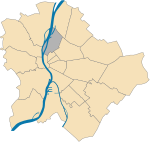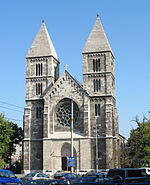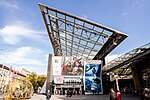Dózsa György út metro station
European rapid transit stubsHungarian building and structure stubsHungarian railway station stubsHungary transport stubsM3 (Budapest Metro) stations ... and 1 more
Railway stations opened in 1984

Dózsa György út is a station on the Budapest Metro Line 3 (North-South). It is located beneath Váci Avenue at its intersection with the eponymous street Dózsa György út. The station was opened on 7 November 1984 as part of the extension from Lehel tér to Árpád híd.
Excerpt from the Wikipedia article Dózsa György út metro station (License: CC BY-SA 3.0, Authors, Images).Dózsa György út metro station
Váci út, Budapest Angyalföld
Geographical coordinates (GPS) Address Nearby Places Show on map
Geographical coordinates (GPS)
| Latitude | Longitude |
|---|---|
| N 47.524166666667 ° | E 19.063333333333 ° |
Address
Váci út 23-27
1134 Budapest, Angyalföld
Hungary
Open on Google Maps









